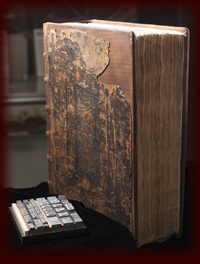 |
 |
 An Exhibit in Honor of the 400th Anniversary of the King James Version of the Bible Located at the Special Collections & Archives in the David O. McKay Library at BYU-Idaho, Rexburg, ID May-December 2011 | |
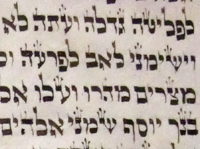 Torah Section, 19th Century (original) Anciently the word of God was preserved on leather scrolls. These scrolls were carefully copied and preserved through the ages. The scroll section in the exhibit is from a “Sefer Torah” which is used in Jewish religious services. The Torah contains the first five books of the Old Testament. The text is handwritten in Hebrew on vellum in a very strict traditional method by specially trained scribes. The text in this section is from Genesis. |
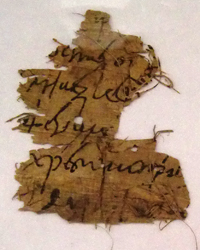 Papyrus Fragment, A.D. 70 (original) This ancient papyrus fragment contains a religious text written in Greek. It was produced about the same time that many books of the New Testament were written. |
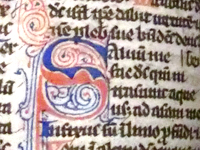 Vulgate Bible, 13th Century (original) The Bible text was translated from Greek into Latin by St Jerome in 406 A.D. This translation was used during the Middle Ages, roughly 400 A.D. to 1400 A.D. Bibles were popular but expensive. Each was copied by hand onto sheets of parchment or vellum that were made from the hides of animals. The Vulgate Bible in the exhibit was created in Paris, France and is beautiful example of medieval workmanship. |
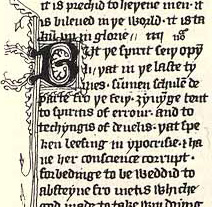 Wycliffe's New Testament, 1383 (facsimile) John Wycliffe was a professor of theology at Oxford who believed that it was more important to follow the law of the scriptures than the laws of the Catholic church. He was the first Englishman to translate the Bible from Latin into English. All copies of these Bibles were hand-written. |
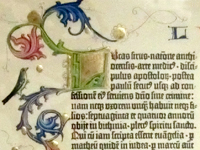 Gutenberg's Bible, 1455 (facsimile) Johannes Gutenberg invented movable type and revolutionized how books were produced. With the invention of the printing press, the cost of books was reduced and more people could afford them. The first book produced on the printing press was the Bible in Latin. At this time Constantinople, a major center of Christendom, fell to the Ottoman Turks. Thousands of people , including Greek scholars fled the city and moved to Europe, along with their sacred books. This influx of Greek Biblical texts encouraged European scholars to reassess the accuracy of the Vulgate translation of the Bible. |
 Luther's New Testament, 1529 (original leaf) Erasmus of Rotterdam was a devout Catholic and an excellent scholar. He realized that the Latin Vulgate was a corrupt translation and wanted to make a better one from the original Hebrew and Greek. In 1516 he published his Parallel Greek/Latin New Testament, using the more reliable Greek to render a fresh Latin version. Martin Luther relied on this text for his German translation of the Bible first published in 1522. |
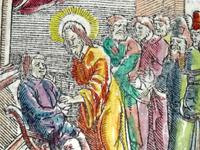 Tyndale's New Testament, 1552 (original leaf, hand colored) WilliamTyndale, a priest and popular university teacher, and linguistic genius wanted to translate the Bible from Latin which only scholars could read, into English for the all people. His ideas were not popular with English church and state. He was forced to flee to Germany where he translated and printed the New Testament in English in 1525. Copies of his New Testament were smuggled into England in bales of cotton and sacks of flour. Officials tried to confiscate or buy and destroy as many copies as they could. Tyndale was was burned at the stake in 1536. His New Testament became the basis for later English Bible translations. |
 Coverdale Bible, 1535 (original leaf) Miles Coverdale used Tyndale's New Testament translation, and based his Old Testament translation on Martin Luther's German Bible and the Vulgate. The first edition of Coverdale's Bible was printed in Antwerp, Belgium. But the political climate in England had changed and King Henry VIII now wanted an English Bible. The second edition of this Bible was printed in England in 1537. It was the first complete English Bible printed on English soil. |
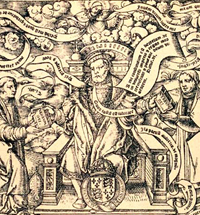 Great Bible, 1539/40 (original) In 1539 Thomas Cromwell, Henry VIII's official over ecclesiastical affairs, and Thomas Cranmer, the first Protestant Archbishop of Canterbury, published a Bible intended to be made available in every parish in England. A team of scholars, led by MilesCoverdale, relied heavily on Tyndale's translation to produce what became known as the Great Bible. |
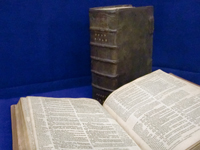 Geneva Bible, 1608 & 1615 (original) Queen Mary (1553 to 1558) tried to reinstate the Catholic Church as the state church in England by force. During her reign English Protestants fled to Geneva, Switzerland, where they worked on a new English translation of the Bible. It was first printed there in 1560. This was the first English Bible to be translated entirely from the original languages (Hebrew for the Old Testament and Greek for the New). The Geneva Bible was the version taken to the New World by Jamestown and New England settlers and remained the world's most popular Bible for nearly a century, going through 140 printings. |
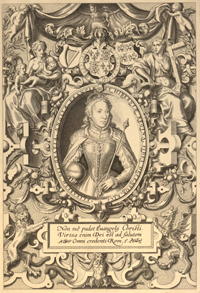 Bishop's Bible,1601 (original) Queen Elizabeth I (1558-1603) enjoyed reading the scriptures in English. Although she liked the Geneva Bible, she could not tolerate the marginal notes that were too Calvinistic and critical of the Anglican Church. So she appointed a committee of scholars to craft a new translation. The Bishop's Bible, as it was known, first appeared in 1568. It never gained popularity, in part because although it was technically correct, it was an awkward translation. |
 Rheims New Testament, 1601 (original) As the end of the 16th century approached, the Catholic Church decided that it was time to produce their own version of the Bible in English, so they undertook a new translation of the 1000-year-old Vulgate. This became known as the Douai-Rheims Bible. The New Testament was first printed in Rheims, France in 1582, followed by the Old Testament in two volumes in Douai, France in 1609-1610. Below: Douai Title Page 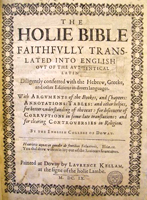 |
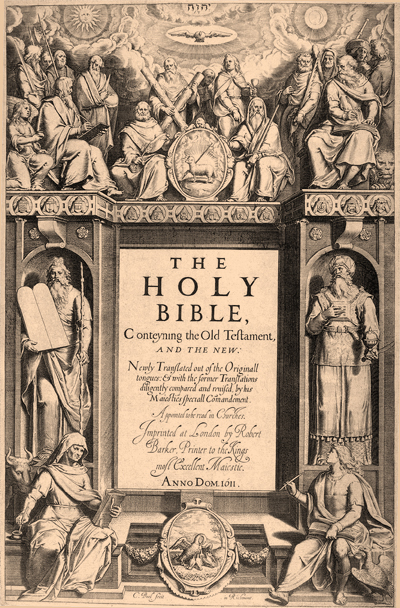 |
King James Bible, 1611 original James I became King of England in 1603. Almost immediately he was approached by a group of clergy who persuaded him to authorize an improved English translation of the Bible. James authorized the formation of a committee of about 50 scholars who began their work in 1607. They were directed to work from original Hebrew and Greek manuscripts and earlier English versions including:
|
 original The Royal Mint of England has issued a commemorative coin in celebration of the 400th anniversary of the King James Bible. The reverse of the coin represents the printing process with the quote from John 1:1, “In the beginning was the Word.” |
|
Familiar Phrases found only in the King James Version of the Bible
|
|||
| McKay Library Exhibits Homepage | McKay Library Homepage |